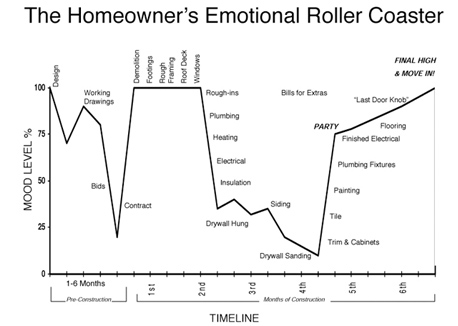For this final installment, I thought I’d provide a kind of recap of the key points to keep in mind when working with and managing the Emotional Homeowner. Check these off your to-do list and you’ll be well on your way to a successful project and satisfied client.
✓ Put it in writing. You have heard this more times than you probably care to remember. Undertaking any kind of construction project requires that everything be put in writing. For obvious reasons, the homeowner shouldn’t and can’t do this. They don’t understand specifications and usually don’t have experience putting together a construction agreement. As the experienced pro, make sure you define each and every part of the project. It’s also your job to make sure that homeowners understand any agreement they are signing. Which is why you should…
✓ Review your contract thoroughly. A thorough contract review should occur before any contract is signed. Before the job begins, do a contract review to ensure that everyone knows what is expected. This review should be clear and easy to understand. Make sure everyone is in agreement on what is going to happen, when it’s going to happen and who is responsible.
✓ Clarify job specifications. Provide homeowners with a complete specifications list detailing every conceivable item that will go into their home improvement project. With a detailed specifications list, you will reduce potential cost overruns by identifying all of the “parts” that are going into their project. In doing so, you’ll also minimize—if not completely eliminate—confusion and misunderstandings. Detailed specifications clearly specify what materials are being used in a project. So nothing is left to chance. It may mean more work up front, but it provides immense advantages:
• When all or most product selections are made prior to starting a job, the job cannot be delayed by homeowner indecision. If all their decisions have been made, you can order any special items that have a long lead time, and you can schedule a project effectively.
• You now have a document that provides your installer or field employee with everything he or she needs to complete the job. If you have carefully specified every part, you will not receive calls about any of the job specifications because they will have all of the information right in front of them.
Specifications are not just the list of materials necessary to build or repair the project referred to to in your working agreement, they also act as an informal insurance contract. As such, they should detail the exact brand, make, model, number, style, type, color, shade, size, weight, thickness and any other description of all the materials you will use to complete any project. Such a set of specifications eliminates the gray areas between you and your clients and will enable you to tell them exactly how much their project will cost.
You can successfully manage a remodeling job by managing emotional homeowners. Remember: On some level or another, they’re all emotional, so spend a little time understanding their fears and then building trust. The three major steps include:
• Understanding them. Realize that this period is an emotional time for the people you work for. They are going to have upsets. Expect them and be ready to deal with them. It’s also a fearful time. Gear everything you do toward reducing their fears.
• Building trust by assuming a parental role. Be consistent. Be honest. Keep your promises. Provide reassurance.
• Keeping them informed. Agree to job procedures before the job starts. Provide them with a paper trail of everything that’s going on.
Now, I can’t promise you that following the recommendations above will help you avoid every adversarial experience that comes up during a home improvement project. However, do so will give you a handle on effectively managing most emotional homeowners. Do this well, and you will build a strong customer base, which will in turn provide you with ongoing customer referrals. When that happens, you can begin to pick the jobs you want to work on, because this effective management skill is in strong demand.
Home improvement and remodeling are service businesses, and people work with people they like. These strategies will allow you to manage the most unpredictable part of your business—the emotional homeowner.
—David Lupberger was formerly ServiceMagic.com’s Home Improvement Expert. He draws on more than two decades of experience in the residential remodeling field, working with remodelers to develop proven business systems. More than 90 percent of Lupberger’s work came from repeat and referral business, demonstrating the trust he developed with clients. That experience led him to write a book called Managing the Emotional Homeowner, which has become one of the bibles of the remodeling industry.
Miss any of this series? No problem. Here’s a list of past installments:









